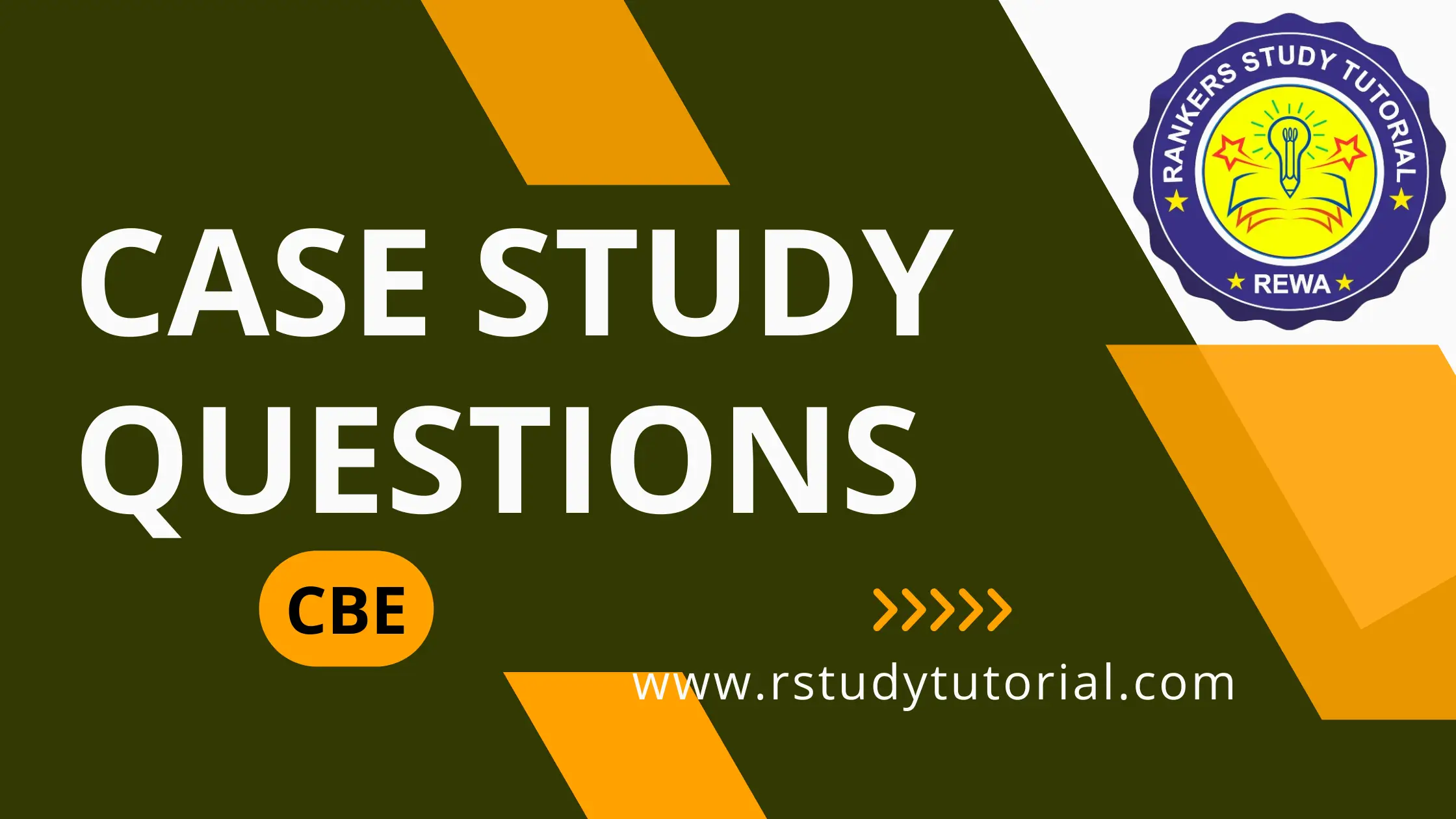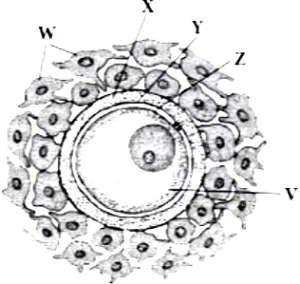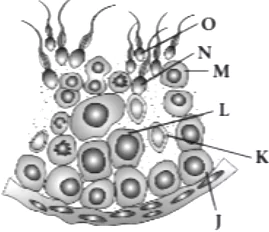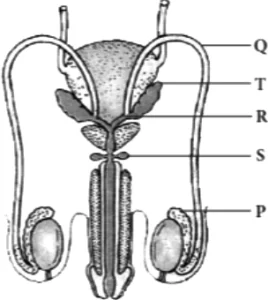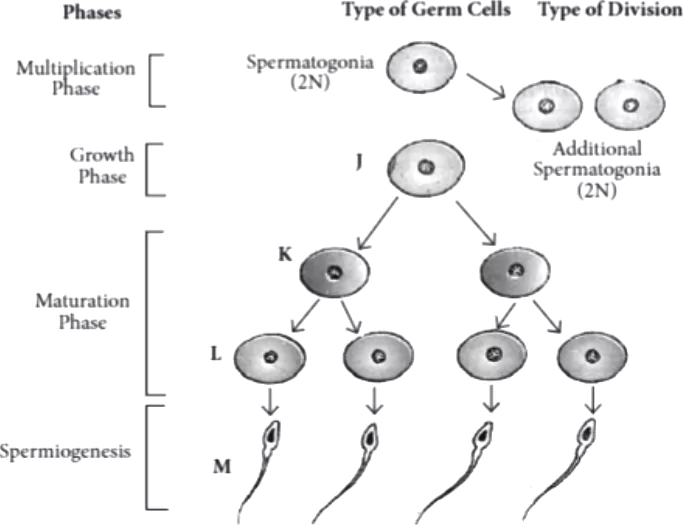Case Study Question 01
Read the following and answer any four questions from 1 to 4 given below:
Study the given table and answer the questions based on it.
Question.1. Identify the hormones X and Y respectively.
(a) Testosterone, FSH
(b) LH, hPL
(c) FSH, hCG
(d) ICSH, hCG
Question.2. W in the given table is
(a) hypothalamus
(b) posterior lobe of pituitary
(c) placenta
(d) ovary
Question.3. Which of the following is correct for Z?
(a) Dilation of uterine cervix during labour pains.
(b) Stimulates the growth of the mammary glands during pregnancy.
(c) Supports the fetal growth and prevents desiccation.
(d) Forms protective plug in cervix of uterus during pregnancy.
Question.4. Which set of hormones is secreted only during pregnancy?
(a) Human chorionic gonadotropin, relaxin and human placental lactogen
(b) Human placental lactogen, estrogen and chorionic thyrotropin
(c) Human chorionic gonadotropin, human placental lactogen and progesterone
(d) Chorionic thyrotropin, chorionic gonadotropin and estrogen
Question.5.
Assertion: Follicle stimulating hormone controls the maintenance and functions of male reproductive organs.
Reason: FSH acts directly on spermatogonia to stimulate sperm production.
(a) Both assertion and reason are true and reason is the correct explanation of assertion.
(b) Both assertion and reason are true but reason is not the correct explanation of assertion.
(c) Assertion is true but reason is false.
(d) Both assertion and reason are false.
Ans.1. (c)
Ans.2. (b)
Ans.3. (a)
Relaxin increases the flexibility of the pubis symphysis and ligaments of sacroiliac and sacrococcygeal joints and helps to dilate the uterine cervix during labour pains.
Ans.4. (a)
hPL, hCG and relaxin are produced in women of uterus. only during pregnancy.
Ans.5. (b)
Case Study Question 02
Read the following and answer any four questions from 1 to 5 given below:
During copulation, semen is released by the penis into the vagina. The motile sperms swim rapidly, fuse with ovum in the ampullary region, resulting in fertilisation. Haploid nucleus of sperm fuse with that of ovum to form diploid zygote.
Question.1. In female genital tract, sperms are made capable of fertilising the egg. This phenomenon of sperm activation is called
(a) amphimixis
(c) capacitation
(b) cortical reaction
(d) acrosomal reaction.
Question.2. Select the correct sequence of various physical and chemical events that take place during fertilisation.
P. Fusion of cortical granules with plasma membrane of secondary oocyte.
Q. Formation of fertilisation cone to receive sperm.
R. Release of sperm lysin from acrosome.
S. Mixing up of chromosomes of a sperm and an ovum.
(a) R → Q → P → S
(b) Q → S → R → P
(c) Q → R → S → P
(d) R → P → Q → S
Question.3.
Assertion: Only one sperm can fertilise an ovum.
Reason: The secretion of acrosome help the sperm to enter into cytoplasm of ovum through zona pellucida and plasma membrane.
(a) Both assertion and reason are true and reason is the correct explanation of assertion.
(b) Both assertion and reason are true but reason is not the correct explanation of assertion.
(c) Assertion is true but reason is false.
(d) Both assertion and reason are false.
Question.4. What is the significance of fertilisation?
(a) It restores haploid number of chromosomes.
(b) It produces offspring genetically identical to parents.
(c) It initiates cleavage.
(d) Both (b) and (c)
Question.5. Site of fertilisation in humans is
(a) endometrium of uterine cavity
(b) ampullary isthmic junction of oviduct
(c) cervix of uterus
(d) infundibulum of fallopian tube.
Ans.1. (c)
The secretions of female genital tract remove coating substances deposited on the surface of the sperms. This phenomenon of sperm activation is called capacitation.
Ans.2. (d)
Ans.3. (b)
Binding of sperm to the secondary oocyte induces depolarisation of the oocyte plasma membrane. Depolarisation prevents polyspermy and ensures monospermy.
Ans.4. (c)
Fertilisation restores diploid number of chromosomes. It introduces variations as it combines characters of the two parents.
Ans.5. (b)
Case Study Question 03
Read the following and answer any four questions from 1 to 5 given below:
The mature ovum or a female gamete is spherical in shape. The human ovum is almost free of yolk and is said to be alecithal. Human ovum loses its ability to be fertilised about 24 hours after ovulation. Refer to the given structure of ovum and answer the following questions.
Question.1. Thick cellular layer formed of radially elongated follicular cells is
(a) zona pellucida
(b) plasma membrane
(c) perivitelline membrane
(d) corona radiata.
Question.2. In humans, at which stage does ovum get released from ovary?
(a) Secondary oocyte
(b) Oogonium
(c) Primary oocyte
(d) First polar body
Question.3. Cytoplasm of an ovum is enveloped by
(a) zona pellucida
(b) corona radiata
(c) cell membrane
(d) perivitelline space
Question.4. Select the correct option.
Question.5. Which of the following is not a characteristic of an ovum?
(a) Nucleus of an ovum has prominent nucleolus.
(b) Only one ovum formed from one oogonium.
(c) It lacks centrioles.
(d) It has very small amount of ooplasm.
Ans.1. (d)
Ans.2. (a)
In humans, ovum is released from the ovary as secondary oocyte.
Ans.3. (c)
Ans.4. (b)
V-Cortical granules
W-Cells of corona radiata
X-Zona pellucida
Y- Perivitelline space
Z-Plasma membrane
Ans.5. (d)
Ovum has large amount of cytoplasm called puberty the seminiferous tubules start producing ooplasm.
Case Study Question 04
Read the following and answer any four questions from 1 to 5 given below:
Each testicular lobule of testis contains one to three highly coiled seminiferous tubules. Wall of each seminiferous tubule is formed of single layered germinal epithelium. Majority of cells in this epithelium are cuboidal called male germ cells. Study the transverse section of part of seminiferous tubule and answer the following questions.
Question.1. What is the characteristic of K?
(a) K is spermatogonium which grows into primary spermatocyte.
(b) K is Sertoli cell which provides nutrition to spermatids.
(c) K is secondary spermatocyte which undergo meiosis II to form spermatid.
(d) K is spermatid being converted into sperm.
Question.2. Which of the following cell undergo reduction division to form secondary spermatocyte?
(a) J
(b) M
(c) L
(d) K
Question.3. How many among the following have 46 chromosomes?
(a) 2
(b) 4
(c) 5
(d) 3
Question.4. Select an option that correctly identifies different labels.
(a) L – Primary spermatocyte, N – Spermatozoa, M – Secondary spermatocyte
(b) J – Spermatogonium, K – Sertoli cell, O – Spermatozoa
(c) L – Primary spermatocyte, M – Secondary spermatocyte, N – Spermatozoa
(d) J – Spermatogonium, K – Primary spermatocyte, N – Spermatid
Question.5. Which hormone initiates spermatogenesis at puberty?
(a) FSH
(b) ICSH
(c) ABP
(d) GnRH
Ans.1. (b)
Ans.2. (c)
J – Spermatogonium,
K – Sertoli (sustentacular) cell,
L – Primary spermatocyte,
M – Secondary spermatocyte
N – Spermatid,
O – Spermatozoa.
Ans.3. (a)
Spermatogonium and primary spermatocytes are diploid (2N), i.e., 46 chromosomes.
Ans.4. (b)
Ans.5. (d)
Spermatogenesis starts at puberty due to significant increase in the secretion of GnRH.
Case Study Question 05
Read the following and answer any four questions from 1 to 5 given below:
Cleavage is the series of rapid mitotic divisions in zygote and forms blastula. The 2, 4, 8, 16 daughter cells are called blastomeres. Embryo with 64 blastomeres is known as blastocyst and has blastocoel cavity. Blastocyst gets implanted in uterine wall and leads to pregnancy.
Question.1. Solid mass of cells with 16 blastomeres is called
(a) morula
(b) blastula
(c) gastrula
(d) zygote.
Question.2. At which stage of embryonic development trophoectoderm develops?
(a) Zygote
(b) Morula
(c) Blastula
(d) Gastrula
Question.3. Site of implantation is
(a) endometrium of uterus
(b) cervix
(c) uterine fundus
(d) infundibulum of oviduct.
Question.4. Correct sequence of various structures formed during embryonic development is
(a) Morula → Embryo → Gastrula → Blastula
(b) Zygote → Embryo → Morula → Blastula
(c) Blastula → Morula → Gastrula → Embryo
(d) Zygote → Morula → Blastula → Gastrula.
Question.5.
Assertion: Side of blastocyst with inner cell mass is called animal pole.
Reason: Inner cell mass gives rise to embryo.
(a) Both assertion and reason are true and reason is the correct explanation of assertion.
(b) Both assertion and reason are true but reason is not the correct explanation of assertion.
(c) Assertion is true but reason is false.
(d) Both assertion and reason are false.
Ans.1. (a)
Embryo with 8-16 blastomeres is solid mass of cells, known as morula.
Ans.2. (c)
Embryo with 64 cells is called blastula (blastocyst) and has blastocyst cavity. Blastocyst is composed of an outer envelope of cells called trophoblast and inner cell mass.
Ans.3. (a)
Implantation is the attachment of blastocyst to the uterine wall. The portion of blastocyst where the inner cell mass is located lies against the endometrium of uterus.
Ans.4. (d)
Ans.5. (b)
Case Study Question 06
Read the following and answer any four questions from 1 to 5 given below:
Human male reproductive system comprises of a pair of testes, primary sex organs associated with formation of gametes and production of sex hormone. Study the given figure of human male reproductive system and answer the following questions.
Question.1. Which of the following is correct for labelled part P?
(a) P is rete testis which transports sperms to outside.
(b) P is epididymis which secretes fluid that nourish the sperms.
(c) P is epididymis that carry sperms and secretion of seminal vesicles.
(d) P is rete testis which lies along inner side of each testis and stores the sperms.
Question.2. Identify the correctly matched pair.
(a) Q-Vasa efferentia
(b) R- Ejaculatory duct
(c) S-Seminal vesicle
(d) T-Cowper’s gland
Question.3. Which statement is incorrect for Q?
(a) It carries spermatozoa from epididymis to ejaculatory duct.
(b) Q are only 2 in number.
(c) It arises from rete testis.
(d) It constitutes male sex accessory duct.
Question.4. Which structure passes through the prostate gland and carries sperms and secretion of seminal vesicle?
(a) P
(b) T
(c) S
(d) R
Question.5.
Assertion: Mucus present in secretion of bulbourethral gland decreases the number of sperms damaged during ejaculation.
Reason: Mucus lubricates the end of penis and lining of the urethra.
(a) Both assertion and reason are true and reason is the correct explanation of assertion.
(b) Both assertion and reason are true but reason is not the correct explanation of assertion.
(c) Assertion is true but reason is false.
(d) Both assertion and reason are false.
Ans.1. (b)
P is an epididymis that stores the sperms and secretes a fluid which is considered to nourish the sperms.
Ans.2. (b)
Q – Vas deferens, R – Ejaculatory duct S – Bulbourethral gland, T – Seminal vesicle
Ans.3. (c)
Q (vas deferens) arises from cauda epididymis.
Ans.4. (d)
Ans.5. (a)
Case Study Question 07
Read the following and answer any four questions from 1 to 5 given below:
Oogenesis is the process of formation of ovum in ovaries. It consists of three phases: multiplication, growth and maturation. Oogenesis is controlled by hormones GnRH, LH, FSH. GnRH secreted by the hypothalamus stimulates the anterior lobe of pituitary gland to secrete LH and FSH.
Question.1. What is the function of hormone FSH?
(a) It inhibits the formation of estrogen.
(b) It induces the release of secondary oocyte
(c) It stimulates the growth of Graafian follicles.
(d) It causes ovulation.
Question.2. Which hormone induces the rupture of the mature Graafian follicle?
(a) Follicle stimulating hormone
(b) Gonadotropin releasing hormone
(c) Progesterone
(d) Luteinising hormone
Question.3. Which cell division is involved in the formation of secondary oocyte?
(a) Mitosis
(b) Meiosis I
(c) Amitosis
(d) Meiosis II
Question.4. Identify the function(s) of LH.
(A) Release of secondary oocyte from Graafian follicle.
(B) Stimulates corpus luteum to secrete progesterone.
(C) Stimulates estrogen formation.
(D) Promotes development of egg to form secondary oocyte.
(a) (A) and (B) only
(c) (A), (C) and (D) only
(b) (B) and (C) only
(d) (B) only
Question.5.
Assertion: The increase in progesterone level exerts positive feedback on GnRH.
Reason: The rising level of progesterone stimulate production of FSH and LH.
(a) Both assertion and reason are true and reason is the correct explanation of assertion.
(b) Both assertion and reason are true but reason is not the correct explanation of assertion.
(c) Assertion is true but reason is false.
(d) Both assertion and reason are false.
Ans.1. (c)
FSH stimulates the growth of Graafian follicles, development of egg oocyte within the follicles to complete the meiosis I to form secondary oocyte. It also stimulates the formation of estrogen.
Ans.2. (d)
LH induces rupture of mature Graafian follicle and thereby the release of secondary oocyte.
Ans.3. (b)
Ans.4. (a)
Ans.5. (d)
The rising level of progesterone inhibits the release of GnRH, which in turn inhibits production of FSH, LH and progesterone.
Case Study Question 08
Read the following and answer any four questions from 1 to 5 given below:
The first menstruation is called menarche, that usually occurs between 12 and 15 years. In human females, menstruation is repeated at an average interval of about 28/29 days and is called menstrual cycle. It is regulated by certain hormones, as pituitary gland is stimulated by releasing factors produced in the hypothalamus. The hormones produced by pituitary gland influence the ovaries. The hormones secreted by the ovaries affect the walls of the uterus.
Question.1. The breakdown of endometrium is characteristic of
(a) proliferative phase
(c) ovulatory phase
(b) luteal phase
(d) menstrual phase.
Question.2. Which days of the menstrual cycle marks the proliferative phase?
(a) 1-5
(b) 15-28
(c) 6-13
(d) 10-14
Question.3. Which of the following occurs during secretory phase?
(a) Empty Graafian follicle changes into corpus luteum.
(b) Primary follicle changes into Graafian follicle.
(c) Endometrium rebuilds and estrogen secretion increases.
(d) LH surge inducing release of an ovum.
Question.4. Identify the hormones that attain peak level during ovulatory phase.
(a) FSH
(b) Progesterone
(c) LH
(d) Both (a) and (c)
Question.5. Withdrawal of which hormone causes degeneration of corpus luteum?
(a) FSH
(b) LH
(c) Progesterone
(d) Estrogen
Ans.1. (d)
During menstrual phase, the endometrium breaks down and menstruation begins.
Ans.2. (c)
Proliferative phase extends for about 10-12 days usually from day 6th to 13th in a 28 day cycle.
Ans.3. (a)
Ans.4. (d)
During ovulatory phase, both LH and FSH attain a peak level.
Ans.5. (b)
Case Study Question 09
Read the following and answer any four questions from 1 to 4 given below:
A functional mammary gland is characteristic of all female mammals. Mammary glands are paired structures that contain glandular tissue and variable amount of fat. Refer to the given figure of a mammary gland and answer the following questions.
Question.1. Mammary glands are modified
(a) sweat glands
(b) sebaceous glands
(c) sudoriferous glands
(d) lacrimal glands
Question.2. Identify the incorrectly matched pair.
(a) P-Areola
(b) Q-Lactiferous duct
(c) S-Mammary duct
(d) T-Mammary alveoli
Question.3. Mammary ducts expand to form
(a) mammary alveoli
(b) mammary ampullae
(c) lactiferous ducts
(d) mammary tubules
Question.4. What is areola?
(a) Grape-like clusters of milk secreting structures
(b) Fatty tissue between the mammary lobes
(c) Circular pigmented area of skin around nipple
(d) Connective tissue that supports the alveoli and ducts
Question.5.
Assertion: The size of breast depends on the amount of adipose tissue.
Reason: The adipose tissue supports the alveoli and the ducts.
(a) Both assertion and reason are true and reason is the correct explanation of assertion.
(b) Both assertion and reason are true but reason is not the correct explanation of assertion.
(c) Assertion is true but reason is false.
(d) Both assertion and reason are false.
Ans.1. (a)
Ans.2. (d)
T is mammary ampulla and R is mammary alveoli.
Ans.3. (b)
Near the nipple, mammary ducts expand to form mammary ampullae where some milk may be stored before going to lactiferous ducts.
Ans.4. (c)
Ans.5. (c)
The fibrous (connective) tissue supports the alveoli and the ducts.
Case Study Question 10
Read the following and answer any four questions from 1 to 5 given below:
In testis, the immature male germ cells produce sperms by spermatogenesis that begins at puberty. It occurs in the seminiferous tubules of the testes. Seminiferous tubules are lined by germinal epithelium. Study the schematic representation of spermatogenesis and answer the following questions.
Question.1. Which cell division occurs during multiplication phase?
(a) Mitosis
(b) Meiosis I
(c) Meiosis II
(d) Both (b) and (c)
Question.2. How many chromosomes are present in secondary spermatocyte and spermatid respectively?
(a) 46, 23
(b) 46, 46
(c) 23, 23
(d) 23, XY
Question.3. Transformation of L into M is known as
(a) spermiation
(b) spermateliosis
(c) spermatogenesis
(d) none of these
Question.4. Select the correct option.
(a) Type A spermatogonia grows to larger primary spermatocyte.
(b) One spermatogonium forms two spermatids.
(c) Spermiation is the release of sperms from seminiferous tubules.
(d) Primary spermatocyte undergoes mitosis to form secondary spermatocytes.
Question.5. Which hormone acts on spermatogonia to stimulate sperm production?
(a) LH
(b) GnRH
(c) ABP
(d) FSH
Ans.1. (a)
In multiplication phase, the undifferentiated primordial germ cells divide several times by mitosis to produce large number of spermatogonia.
Ans.2. (c)
Ans.3. (b) Transformation of spermatids (L) into spermatozoa (M) is known as spermiogenesis or spermateliosis.
Ans.4. (c)
Ans.5. (d)
FSH acts on spermatogonia to stimulate sperm production.

